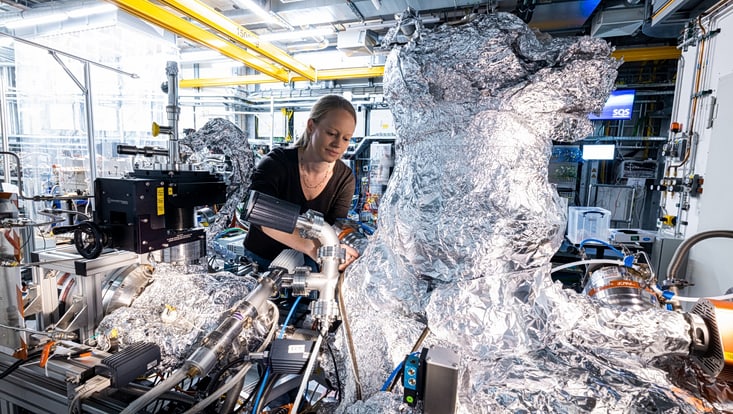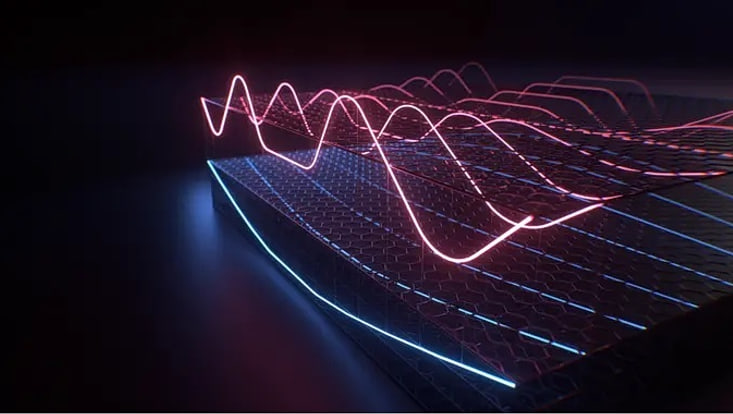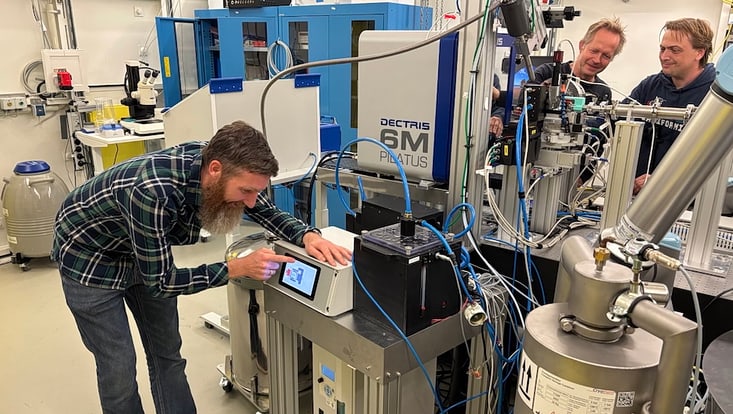Imaging of Matter
Revealing quantum fluctuations in complex molecules
7 August 2025

Photo: European XFEL
Due to the Heisenberg uncertainty principle of quantum physics, atoms and molecules never come completely to rest, even in their lowest energy state. Researchers at the European XFEL in Schenefeld near Hamburg have now been able to directly measure this quantum motion in a complex molecule for the first time. For this, however, as they report in the journal Science, they had to make the molecule explode in the process.
Absolute standstill only exists in classical physics. In the quantum world, even the ground state with the lowest energy is characterized by persistent fluctuations. This is due to a quantum-mechanical principle discovered by Werner Heisenberg a hundred years ago during the development of quantum mechanics. The so-called zero-point fluctuations are a quantum effect that prevents atoms from remaining precisely at a fixed position, even at temperatures near absolute zero. At European XFEL in Schenefeld, researchers have now made the previously invisible directly observable – and the quantum world a bit more tangible.
An international team led by Rebecca Boll from the SQS (Small Quantum Systems) instrument at European XFEL in Schenefeld, Ludger Inhester from DESY and the Cluster of Excellence "CUI: Advanced Imaging of Matter" and Till Jahnke from the Max Planck Institute for Nuclear Physics in Heidelberg, succeeded in visualizing the collective trembling of an entire molecule. Using a sophisticated experiment and refined data analysis, they were able to measure the quantum fluctuations of the 2-iodopyridine molecule (C5H4IN), which consists of eleven atoms – a milestone in molecular imaging. They describe their work in the renowned journal Science.
A microscopic big bang: the atomic cores fly apart in an explosion
The researchers employed a method as spectacular as its name: Coulomb Explosion Imaging. The ultrashort, extremely intense X-ray laser pulses of European XFEL strip numerous electrons from the atoms of individual 2-iodopyridine molecules very rapidly. The remaining atomic cores become positively charged, repelling each other. The result resembles a microscopic big bang: the atomic cores fly apart in an explosion.
Nonetheless, from the measured flight directions and velocities of the fragments, the researchers can reconstruct the original arrangement of the atoms – and more than that: they can even visualize the tiny quantum-mechanical fluctuations.
The 2-iodopyridine molecule is a so-called pyridine ring. It consists of a carbon ring incorporating a nitrogen atom. An iodine atom is attached to this pyridine ring. From a classical perspective, the entire molecule is perfectly planar – meaning that all its atoms lie exactly within one plane. If the molecule was a classical object, then after a Coulomb explosion, all atoms and fragments would fly off exactly within the molecular plane. As the researchers studied the molecule in its ground state, deviations due to possible molecular vibrations can be excluded.
Charged atoms are detected outside the expected molecular plane
Nevertheless, the team detected charged atoms outside the classically expected molecular plane. Their measurements matched detailed simulation calculations that also included machine learning methods. “In these calculations, we explicitly had to include the quantum fluctuations in order to reproduce the data,” says Cluster researcher Benoît Richard from DESY and the University of Hamburg, first author of the Science paper.
“We could furthermore see the collective nature of the quantum fluctuations in the measurement data,” Ludger Inhester adds. “That is, the atoms in the molecule do not tremble independently of each other, but move in coordinated patterns.”
The measurement data were recorded with a detector called a COLTRIMS (REMI) reaction microscope – one of the endstations available to users at the SQS instrument. With this device, many of the fragments can be recognized and spatially assigned at the same time.
“We already saw first indications of this correlated behavior of the atoms in the data back in 2021, but it took a while to really understand everything and convince our colleagues of this remarkable finding,” says Till Jahnke from the Max Planck Institute for Nuclear Physics in Heidelberg. One challenge was that not all fragments of the molecule can be detected in every X-ray pulse. The researchers overcame this obstacle by using a new statistical analysis method developed by Benoît Richard, which can reconstruct the complete momentum distribution of the molecule even from such fragmentary datasets. “Furthermore, the very intense X-ray flashes from European XFEL make each molecule explode very efficiently and in a very similar way,” emphasizes Rebecca Boll. “With this method, we were able to decipher the structure of the entire molecule,” explains CUI scientist Robin Santra from DESY and the University of Hamburg. The researchers also clearly detected the “fingerprints” of the atoms’ quantum fluctuations.
New avenues for exploring complex quantum mechanical systems
The new method opens entirely new avenues for exploring complex quantum mechanical systems. “Coulomb Explosion Imaging does not just provide averaged values, such as X-ray crystallography for example, but allows us to investigate individual molecules,” says Boll. “In the future, this technique could be used to study even larger molecules, and time-resolved movies of their internal motions are now possible,” explains Michael Meyer, leading scientist at the SQS instrument and Cluster researcher: “And this with a time resolution of less than one femtosecond, that is, within a quadrillionth of a second.”
A follow-up project will be funded next year within the Excellence Strategy of the German federal and state governments as part of the recently extended Excellence Cluster “CUI: Advanced Imaging of Matter”. CUI is a cooperation of the University of Hamburg with DESY, the Max Planck Institute for the Structure and Dynamics of Matter (MPSD), and European XFEL.
The newly published work impressively demonstrates what is possible when cutting-edge laser technology, quantum mechanics, and sophisticated data analysis come together. Text: XFEL, ed.
Citation:
Benoît Richard, Rebecca Boll, Ludger Inhester, and Till Jahnke et al.
Imaging collective quantum fluctuations of the structure of a complex molecule
Science 389, 6760 (2025)


